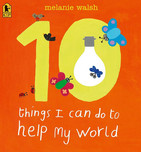Storytime! Teaching about climate through environmental storybooks
- Lukasz Krzywon

- Apr 20, 2021
- 7 min read
Updated: Apr 22, 2021
"Story, as it turns out, was crucial to our evolution - more so than opposable thumbs. Opposable thumbs let us hang on; stories told us what to hang on to." Lisa Cron, Wired for Story
Humans are storytellers and storylisteners by nature. Storytelling is something unique to our species, together with other cultural attributes like pictures and music. Stories are essential to learning, this can obviously be done in better or worse ways, but we all learn through stories from the very first days of our lives. It is enough to look at the oral cultures to see the importance of it as an educational tool.
When we want to teach about environmental issues we need to focus on two primary dimensions – convey the facts, knowledge, and awake the stewardship spirit in the new generations. We can accomplish this in various ways. Playing outdoors is one of the simplest ways to build a connection to nature that can result in more compassionate and responsible attitude towards life on our planet. But there is another tool that elders, and teachers were using from times immemorial. It’s a story.
“Stories have been used since time immemorial to record important events, celebrate the feats of heroes and heroines, transmit the spirit and facts of a major occurrence, and point out patterns of human experience and behaviour. Storytelling is a cornerstone of the teaching profession. Researchers have noted the significance of storytelling in oral cultures that have persisted over time. Stories help tribe members to make sense of their collective experiences, such as illness, death, and conflict, as well as interrelationships, including courtship, marriage, childbirth, and stewardship of nature. An oral culture teaches tribe members to preserve the wisdom of their heritage, transmit skills, maintain respect for elders, and understand how children fit into their lives” Stan Koki
Science of education teaches us that our brains and especially the hippocampus use “gossip” (term by Robert Dunbar) to learn about the world. We learn very efficiently if the information has character of a novelty, it encompasses a social aspect (involve other human beings), it has an element of surprise and lastly, it’s been given a form of a story. This unique way of learning is no doubt the consequence of the evolution of our species. Remember about those four aspects of acquiring facts if you’d like to write your own story one day or you want to make an information interesting and memorable.
"You’re never going to kill storytelling, because it’s built in the human plan. We come with it.” Margaret Atwood, author of The Handmaid's Tale
Let's have a look at some examples of the stories that one could use to teach about climate change, since this together with biodiversity loss and pollution, are the biggest challenge we face as a humanity. According to David Sobel in his work on place-based education and ecophobia there is no point in throwing too many facts on children and explain problems that may be to abstract to grasp for the younger audience. And yet, we want to prepare the younger generations and familiarise them with something they will encounter in their lives as they grow up. Although they are not to blame for the actions of the previous generations, they do participate and are immersed in the culture that created the problems. Let’s hope some of the stories could help them understand some of the aspects of the global challenge we all face. Ideally the story that could do that would have explained in simple terms where the problem lies (human-caused global warming) and some solutions (simple actions that they and their family could do).
There are different kind of stories. Some are more direct and some more symbolical, fairytale-like. A lot of them will use animals as the main characters. In more traditional stories there were monsters too or other very terrifying characters (like the old witch, wolf etc). The usually played the role of setting boundaries between good and bad, teaching consequences of actions. Sometimes they’ve served as the guardians or the guides for the rites of passage. I think those are lately missing in many of the stories we present to our children. We don’t want to frighten children, and yet those characters were humanity’s best friends. That’s probably the reason why we still read the old good Grimm’s brother stories now and then.
Since the problem of climate change and environmental crisis is something we have never faced before, we need new stories that would help the new generation gain an understanding of it and a new, positive narration that will guide us in the future.

Dr Seuss’s “Lorax” is already a classic and served well many of us. Because it’s already a part of the mainstream culture I’ll try to show some stories that might be less known and deal directly with climate change. Let’s look at three examples of new storybooks that talk about it and engage children in various ways.

The first book we’ll look at is the “Perry, the Polar Bear goes green. Story about the Global Warming” by Olive
O’Brien. This story looks at the cause of the global warming, by using the character of Perry, a polar bear. As we know, the polar bear became a symbol and an emblem of the melting ice and global warming. Although it seems the it’s not all that bad with the polar bears in the real life (it’s not great either), the picture of a struggling polar bear became part of the culture and this particular story utilizes it to teach about causes and solutions to the global warming. It will probably be suite more for children from 1st class onwards in primary school. The story is very explicit in explaining the facts and proposing different actions. Nevertheless, it’s a story that can engage children, in real life we don’t have polar bears speaking English after all!

Another story that conveys the same message but in a completely different way is “The trouble the dragons” by Debi Gliori (here is how I do this in the classroom). In this book author, in the form of a fairytale presents all the problems related to global warming and climate change. It shows a world where there are dragons and they blow a lot of hot air. The dragons are a metaphor of our consumeristic lifestyle. Dragons keep on destroying the world and finally they need to face the problem of all the wildlife going away. Only then the dragons plead “Don’t go” and “We’ll change”. Other animals explain to the dragons what they need to do. By the way this story also utilises the image of polar bear on the melting ice. So far, I think it’s one of the best stories I came across to present this problem to the children. The illustrations are really amazing and very suggestive. Having tested in the classroom it worked well with even the youngest classes in primary school.
We had lots of fun figuring out who the dragons reminded us of and what they needed to change to solve the problem they've caused.
Check the new resources I have developed for Green-Schools Ireland to talk about ethics of climate change. One of the lesson plans uses the thought experiment of tragedy of the commons.

The last book I want to mention is “Common ground. Water, earth and air we share” by Molly Bang. I’ve used this book before as a means of starting conversations about taking action to protect the planet. The story begins with explaining a classical philosophical problem – tragedy of the commons - and present it in very simple way with excellent illustrations that help visualising it. It then proceeds to show how the tragedy plays out in our real world and with our limited resources. The book ends up with a question, that can be a start of a debate about solutions, motivations to act on climate change and the shared responsibility. The book is dedicated to older children in primary school. I’ve written in another document how you can one use this kind of a story as stimuli to have an ethical inquiry into climate change.
“A well-told science story does three important jobs: It brings facts to life. It makes abstract concepts concrete. And through the virtual reality of storytelling, it walks listeners through the process approach to scientific inquiry. Facts are important, and storytelling is one of the most effective ways of delivering them. But if you stop with facts you are not teaching science. Science should be a verb, an activity, not simply a body of knowledge.” Brian Ellis
TIPS FOR READING STORYBOOKS TO CHILDREN
Make yourself familiar with the story before you read it to any audience.
Try to make sure each character talks differently – this makes the story come to life for the listeners. You could try making them talk higher or deeper, faster or slower, or even in different accents. If you have trouble thinking up voices, ask your audience to give you ideas for how a certain character might talk – they could even read one character's lines for you...
Ask questions every so often to find out what everyone thinks might happen next. This can help to build the suspense and make it more interesting for your listeners.
Recap what's happened every few pages to make sure your listeners know what's going on (especially important if they're younger).
Quit reading at an exciting point in the story – maybe at the end of a chapter or even in the middle of a sentence! TV dramas use cliffhangers like this to make sure their audience comes back tomorrow to find out what happened – yours will too.
Make sure everyone sees the pictures, you can pause for a moment to show it to everyone, you can shortly discuss what they see. Some of the illustrated stories would have a lot of details that add additional context to the story so it’s worthwhile to look at those.
If you can learn the story by heart and tell it rather than read it, even better.
Have some questions ready that dive into the story after you read and open a discussion with the children.
SOME OF THE STORYBOOKS FOR TEACHING ABOUT ENVIRONMENT





















































Comments